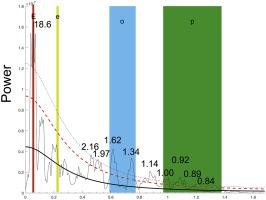Gondwana Research ( IF 6.1 ) Pub Date : 2021-03-13 , DOI: 10.1016/j.gr.2021.02.018 Natalia M. Levashova , Inessa V. Golovanova , D.V. Rudko , Konstantin N. Danukalov , S.V. Rudko , Salmanova R. Yu , Joseph G. Meert

|
The behavior and strength of the Late Ediacaran-Early Cambrian magnetic field may provide a unique background for unravelling controversial plate reconstructions, the nature of the inner core and even biological evolution. Recent studies suggest that the Ediacaran dipole field strength was extremely low and that the magnetic field was in a hyperactive reversing state (>4–6 R/Ma) well into the Cambrian. Data supporting hyperactive reversals are derived from numerous studies of sedimentary successions in Baltica including the 547 Ma Zigan formation in the Urals. Although some of the younger, Cambrian-age, sedimentary sequences have robust age control, estimates of reversal frequency in the Zigan Formation was based on average sedimentation rates. In this study, we returned to a thick (~75 m) section of the Zigan and sampled for both magnetostratigraphic and magnetic susceptibility at a finer scale (~20 cm). The magnetic susceptibility data were used to evaluate orbitally-forced frequency signals that my provide a higher resolution estimate of reversal frequency. In particular, the stable long eccentricity signal of 405 Kyr was recognized in a frequency analysis of magnetic susceptibility. The identification of this periodic signal allowed us to refine the estimate for reversal frequency in the section to 20 R/Ma. Although slightly smaller than an original estimate of 25 R/Ma, this rate is well above the Phanerozoic background reversal rate and 3–5 times higher than the cut-off for hyperactivity. Our study thus confirms the hyperactive reversal interval from at least the latest Ediacaran until sometime in Epoch 3 of the Cambrian.
中文翻译:

Ediacaran晚磁场活动过度:量化俄罗斯南部乌拉尔兹干组的反转频率
Ediacaran-Earcaran早期寒武纪磁场的行为和强度可能为揭示有争议的板块重建,内核的性质甚至生物演化提供独特的背景。最近的研究表明,Ediacaran偶极子的场强极低,并且进入寒武纪的磁场处于活跃的反转状态(> 4–6 R / Ma)。支持多动逆转的数据来自对波罗的海沉积演替的大量研究,包括乌拉尔的547 Ma Zigan地层。尽管某些较年轻的寒武纪沉积层序具有很强的年龄控制能力,但gan干组逆转频率的估算是基于平均沉积速率。在这项研究中,我们返回到滋干的厚(约75 m)断面,并以更细的尺度(〜20 cm)进行了磁地层和磁化率的采样。磁化率数据用于评估轨道强迫的频率信号,这些信号可以提供更高分辨率的反向频率估计。尤其是在磁化率的频率分析中,可以确认到405 Kyr的稳定的长偏心率信号。通过识别该周期性信号,我们可以将本节中反转频率的估算值细化为20 R / Ma。尽管比最初估计的25 R / Ma略小,但该速率远高于生代背景反转速率,并且比多动反应的临界值高3–5倍。


























 京公网安备 11010802027423号
京公网安备 11010802027423号